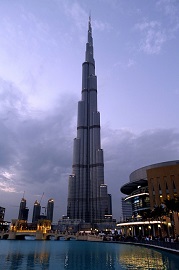Top Architectural Wonders of Dubai
Contents |
[edit] Introduction
Dubai is known for its modern, creative buildings that can be erected quickly and stand out from the crowd in terms of size and design. Some of these architectural wonders have been awarded accolades for their creative design, green credentials and all-round approach.
Below are some of the best.
[edit] Burj Khalifa
The tallest building in the world is over 160 storeys high (829 metres) and is located in Dubai. The Burj Khalifa is a top tourist attraction in the area and the building's architecture has been cleverly assembled, giving its stature. Started in 2004 and completed in 2010, the tip of the spire of the Burj Khalifa can be seen from 95 kilometres away, making it one of the most prominent buildings in the area. You can visit one of the viewing decks and look out on the city skyline – a beautiful sight. This building was built with the need to be recognised internationally, and its amazing architecture now makes it stand proud as one of the most well-known buildings in the world.
[edit] Atlantis, The Palm
Atlantis, The Palm is a beach resort hotel on the man-made Palm Island. The building is based around the myth of Atlantis. Opened by Sol Kerzner in 2008, this building contains 1,539 rooms, 23 restaurants and a nautical-themed water park, amongst other features. There are two towers, referred to as East and West and they are joined together by the Royal Bridge Suite. The architects for this beautiful 23-storey project were from the international firm Wimberly, Tong and Goo.
For more information, see Atlantis, The Palm.
[edit] Cayan Tower
Cayan Tower is also known as the Infinity Tower and is recognised for its interesting twisting shape. It is 306 metres high and was designed by Skidmore, Owings and Merrill (SOM). What makes this building so interesting is the twist itself, which twirls the building around by 90 degrees. Opened in 2013, this fairly new architectural wonder is extremely modern inside and out, filled with Dubai offices and apartments.
[edit] Burj Al Arab
The Burj Al Arab is the third tallest hotel in the world, behind the Rose Rayhaan and the JW Marriott, both also based in Dubai. This establishment rises 280 metres into the sky and stands on its own artificial island, connected to the mainland by a bridge. The architecture of this building is most definitely original, as the idea was for it to look like a relaxed sail of an Arabian ship, called a “dhow”. Led by famous architect Tom Wright, this building was created by 2,000 construction workers and brought to life by over 60 managers and designers – a true architectural feat.
For more information, see Burj al Arab, Dubai.
[edit] Related articles on Designing Buildings Wiki
- 7 Engineering Wonders of the world.
- 9 of the world’s most impressive structures.
- Atlantis, The Palm.
- Bridges of the world.
- Building of the week series.
- Burj al Arab, Dubai.
- Hyperloop in Dubai.
- India needs to build more infrastructure fast. Here’s how.
- Shanghai Tower.
- Tallest buildings in the world.
- The Gherkin.
- Top 10 most expensive construction projects in the world.
- Top 10 skyscrapers located in the UAE.
- Skyscraper.
- Wasl Tower.
Featured articles and news
From studies, to books to a new project, with founder Emma Walshaw.
Types of drawings for building design
Still one of the most popular articles the A-Z of drawings.
Who, or What Does the Building Safety Act Apply To?
From compliance to competence in brief.
The remarkable story of a Highland architect.
Commissioning Responsibilities Framework BG 88/2025
BSRIA guidance on establishing clear roles and responsibilities for commissioning tasks.
An architectural movement to love or hate.
Don’t take British stone for granted
It won’t survive on supplying the heritage sector alone.
The Constructing Excellence Value Toolkit
Driving value-based decision making in construction.
Meet CIOB event in Northern Ireland
Inspiring the next generation of construction talent.
Reasons for using MVHR systems
6 reasons for a whole-house approach to ventilation.
Supplementary Planning Documents, a reminder
As used by the City of London to introduce a Retrofit first policy.
The what, how, why and when of deposit return schemes
Circular economy steps for plastic bottles and cans in England and Northern Ireland draws.
Join forces and share Building Safety knowledge in 2025
Why and how to contribute to the Building Safety Wiki.
Reporting on Payment Practices and Performance Regs
Approved amendment coming into effect 1 March 2025.
A new CIOB TIS on discharging CDM 2015 duties
Practical steps that can be undertaken in the Management of Contractors to discharge the relevant CDM 2015 duties.
Planning for homes by transport hubs
Next steps for infrastructure following the updated NPPF.


























